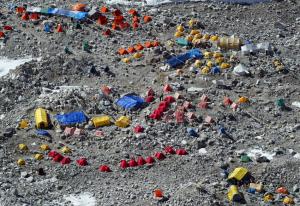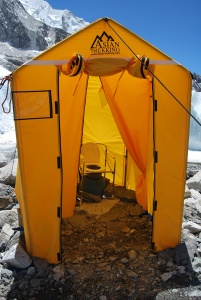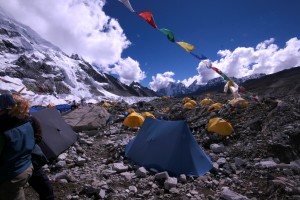Littering Everest: Nature, Toilets, and Waste on Mt. Everest
One of the most recent volleys in a long-running moral critique of consumption, pollution, and imperialism comes from Mt. Everest, where uneasy scholars and activists have long decried the detritus left on the world’s tallest peak. In 1963 National Geographic photographer Barry Bishop was part of the first American team to scale Everest, and he described the mountain as “the world’s highest junk yard.” Indeed, climbers ascending the mountain have discarded oxygen tanks, tattered tents, food containers, and a helicopter, and dead climbers have been left on the peak since George Mallory and Andrew Irvine died in an ascent attempt in 1924. Edmund Hillary and Tenzing Norgay scaled the mountain for the first time in 1953, and Hillary later said “I must admit, when we went to Everest in 1953, we heaved our rubbish around with the best of them. That was nearly forty years ago and in those days hardly anyone had even heard of conservation.” When the New York Times examined the massive growth of tourism to Nepal in 1978, Hillary lamented that the Everest region “is now an ecological slum. Tins and trash clutter up the paths and campsites. … The traditional culture is being crushed by the insidious economic machine.”
Embed from Getty ImagesLast week the head of Nepal’s mountaineering association spearheaded the charge to address the most repulsive of this trash when he took aim on “large amounts of feces and urine” left on the world’s tallest mountain. The Washington Post amplified the rhetoric over human waste on the peak when it repeated Grayson Schaffer’s 2013 description of Everest as a “fecal time bomb,” quite possibly the most colorful description ever provided for a potential ecological disaster. By various counts, over 5000 climbers have relieved themselves on Everest and left “pyramids of human excrement.” In 2012 a Washington Post column by Schaffer had sounded the same jarring image of the Everest base camp outhouses “continuously overflowing with waste.” Last year Outside’s Lauren Steele reported on climbers’ longstanding practice of defecating into glacier crevasses, and with mountain warming “the glacier—and the waste entombed within it—is slowly making its way back toward Base Camp,” where climbers drink the melt water.

In 2003 scores of tents dotted the slopes of Mount Everest’s base camp awaiting their turn to scale the peak (image Getty Images).
A 1992 study found that the digging of small pits to hold human feces at Everest sites had “resulted in the creation of `moonscapes,’” and the two-day walk trail from the Lukla airport to the Everest base camp was referred to as “the `garbage’ or `toilet paper’ trail because of the quantities of refuse generated by trekking groups and individuals.” A 2014 study of Everest trash suggested that each year up to 26,500 pounds of human excrement is deposited on the mountain, and while much of this is transported from base camps to pits at a nearby frozen lake bed the space is beginning to run out.
Elizabeth Mazzolini’s wonderful 2012 analysis of trash on Everest examines the mountain as a historical and cultural marker that evokes a range of contradictions and ambiguities: once a symbol of empire conquered by Great Britain, Everest has often loomed as a symbol of unspoiled nature in its rawest state, even as its ascent today risks appearing to be degraded by uber-wealthy thrill-seeking individualists leaving behind a trail of discards. Mazzolini quite convincingly underscores that feces secures a distinctive status in the pantheon of litter gracing Everest’s slopes, which she examines as a contested terrain on which the meanings of refuse and waste are disputed.

One of the lodges serving Everest trekkers and climbers highlights its “inside toilet” (image from ilka ender).
The trope of Everest as an undifferentiated “junkyard” does not capture the repulsiveness of human waste or the astounding image of “mountains” of excrement piled onto Everest, so excreta makes an especially rich platform for a variety of lamentations about materiality and waste. For instance, the Chicago Tribune’s Rex Huppke intoned that “We took the highest mountain on Earth, one of the world’s most beautiful wonders and arguably the hardest place to access short of the moon, and we conquered it, and then we thought, `Hey, this seems like a cool place to poop.’ … We befoul everything we touch.” In 2011 The Stir’s Lindsay Mannering echoed that the specter of excrement undid her imagination of Everest as untouched wilderness: “When I think of Mount Everest, I think of serene vistas, clean, white snow, and air so crisp you could crack it. Turns out, it’s not exactly as pristine as I’d imagined. The world’s tallest mountain is covered in poop.”
Much of this rhetoric is a shallow effort to shock us with the human defilement of one of the world’s most pristine places: the most remote and undisturbed of all earthly places is fouled by our most symbolically offensive waste. This does not ignore the genuine environmental impacts of pollution on Everest or climbers’ responsibility for ethical environmental stewardship. Instead, it illuminates how we construct various forms of “waste” and how they intersect with our fluid notions of nature, tourism, and consumption. Of course, elimination is a universal reality on mountain climbs, backpacking treks, and moments that otherwise do not include sanitary facilities, but in these moments removed from toilets and sewer systems it is difficult to perpetuate our tendency to imagine human deposits as “out-of-sight, out-of-mind.” Everest climbers are now required to bring down roughly 18 pounds of waste and their own personal refuse; however, hauling refuse back down the peak risks delaying climbers and increasing the already-significant chance of death. Expeditions removed 5000 pounds of trash from the mountain in 1994, and subsequent expeditions have brought down tons of refuse from the peak, but concrete waste management policies for Everest continue to be developed.

A climber ascends Mt. McKinley with a green “clean mountain can” (CMC) strapped to his backpack (image from Coley Gentzel, National Park Service).
Climbers and backpackers have long practiced systematic “poop protocols” governing the disposal of human waste, and parks including Mount Rainier, Mt. Shasta, and Yosemite all have mandatory policies that all human feces must be packed out of the park. The challenge of dealing with the call of nature in the midst of nature is common to many distant places. In 2012, for instance, the Alaska Dispatch estimated that 65 tons of frozen human feces rested on Mt. McKinley (a.k.a., Denali), though the park now uses Clean Mountain Cans to pack out human waste. Research on melting glaciers in the Denali National Park has found that in 15-25 years feces with surviving bacteria will begin to re-emerge from glaciers; the danger of those bacteria to most humans are modest in such a huge ecosystem, but the remains pose dramatic aesthetic and sensory violations that break from an ethic of being good stewards for the environment.
Climate change lurks in the background of many of these discussions on refuse in the most remote “natural” destinations. For instance, Mazzolini underscores that the effects of global warming on Everest could be vastly more threatening to Everest than the refuse scattered on its slopes by lucrative tourist expeditions. Melting snow on Everest has revealed more than a half-century of discards once concealed by snow, so the refuse now hazards appearing to be a problem because of its literal visibility and aesthetic violation of Everest’s fantasized purity.
Canada’s Cirque of the Unclimbables faces a similar half-century record of human waste at the base camp at the foot of some of the Northwest Territory’s most storied climbs. However, when a pit toilet was installed at the Fairy Meadows base camp in 2000 it met with resistance, with Mark Synnott reporting that “for some, the three-foot-square toilet and shoulder-high privacy screens are more unsightly than the turds.” Opponents of the project argued that architecture undermined the appeal of the distant Northwest Territory and signaled the inevitable march of capital into the backcountry, since in the most remote reaches of British Columbia “toilets eventually paved the way for full-scale lodges.”
The disgusting power of elimination is always heightened by its literal presence; for instance, much of 19th and 20th century sanitary reform literature was driven by the material and aesthetic unpleasantness of outhouses, with observers routinely engaging in a sensory rhetoric about the abhorrence of excrement and excretion itself. Perhaps no place could be more “out-of-sight, out-of-mind” than the slopes of Everest, so it is perhaps easy to ignore the scatter of oxygen bottles and tent fragments littering the distant mountain, but the evocative image of a colossal peak covered with human waste is hard to evade. Nevertheless, the Western attention to Everest’s littering risks evading profound sanitary issues in our midst and leaving our own human waste management practices and technologies unexamined. Everest is fantasized as one of the world’s most pristine and undefiled places, so its pollution seems vastly more morally reprehensible than such refuse might in most of urban America, which seems far removed from the notion of “nature.” Tourists and climbers on Mt. Everest certainly should be expected to behave ethically and practice responsible waste management, but much of the discussion on Everest’s human waste deposits constructs waste in powerful sensory ways that are heightened by their placement on the apparently pure white snow of the world’s tallest mountain.
References
Barry C. Bishop
1963 How we climbed Everest. National Geographic 124(4): 477-508.
Brent Bishop and Chris Naumann
1996 Mount Everest: Reclamation of the World’s Highest Junk Yard. Mountain Research and Development 16(3):323-327. (subscription access)
William Borders
1978 Himalayas Lure Tourists To a Forbidding Kingdom. The New York Times 29 May 1978: 10.
Alton C. Byers and Kamal Banskota
1992 Environmental Impacts of Back-country Tourism on Three Sides of Everest. In World Heritage Twenty Years Later, edited by Jim Thorsell, pp. 105-122. The World Conservation Union, Gland, Switzerland.
Paul Lachapelle
1995 A Report on Human Waste Management in Sagarmatha National Park. Unpublished report, Environmental Program, University of Vermont and School for International Training, Kathmandu, Nepal.
Elizabeth Mazzolini
2012 The Garbage Question on Top of the World. In Histories of the Dustheap: Waste, Material Cultures, Social Justice, eds Stephanie Foote and Elizabeth Mazzolini, pp. 147-168. MIT Press, Cambridge, Massachusetts.
The New York Times
1983 Nepal Fears Mount Everest Could Become Pile of Trash. The New York Times
09 Feb 1983: A4.
Stephen Slemon
2000 Climbing Mount Everest: Postcolonialism in the Culture of Ascent. In Postcolonizing the Commonwealth: Studies in Literature and Culture, edited by Rowland Smith, pp. 51-73. Wilfrid Laurier University Press, Waterloo, Ontario.
Jeremy Spoon
2012 Tourism Meets the Sacred: Khumbu Sherpa Place-based Spiritual Values in Sagarmatha (Mount Everest) National Park and Buffer Zone, Nepal. In Sacred Natural Sites: Conserving Nature and Culture, eds. Bas Verschuuren, Jeffrey McNeely, Robert Wild, and Gonzalo Oviedo, pp.88-97. Earthscan, Washingotn, D.C.
Gülnur Tumbat and Russell W. Belk
2011 Marketplace Tensions in Extraordinary Experiences. Journal of Consumer Research 38(1):42-61. (subscription access)
Images
Climber with CMC can image from Coley Gentzel, National Park Service
Everest base camp 2008 image from emlfaulk
Everest base camp toilet tent image from Asian Trekking
Everest garbage collection 2010 image and Everest base camp 2013 image from Getty Images
Posted on March 8, 2015, in Uncategorized and tagged #WPLongform, Mt. Everest, Waste. Bookmark the permalink. 12 Comments.





Reblogged this on O LADO ESCURO DA LUA.
That was an interesting read. I’m surprised to hear that there is not a poop bag mandate. On Aconcagua the group is given a bag with a number and that is given back at the end of the climb, or the group pays a fine.
You should also take in mind that the sherpas still see Mt. Everest as a holy place. All modern expeditions begin with a Puja ceremony in which Sherpas and other team members leave offerings and pay homage to the gods of the mountain, hoping to remain in their good graces throughout the climb, Littering on a holy place is not a sign of respect for other cultures and believings.
Yes, this is absolutely correct and a point that is rarely raised in Western popular media analyses of the issues of tourism on Everest. Some of the Sherpas make this very point in their discussions of managing Everest access.
Reblogged this on Lily Does Archaeology.
Really great post! I absolutely love your blog- I can’t help but visit you almost everyday :p
Thank you! Interesting read. Being agnostic I have a define views about religious believes, nonetheless littering in a sacred place cross the boundaries of respect and ecology. Thanks again. Adrián
Thank you for providing more background on this topic. I had heard of it but didn’t know much. Cultural disconnects for sure.
I’ve heard that littering is also a problem at Mt. Kilimanjaro, another destination trek. And…there’s the space junk that we’ve ejected. What pigs we are.
Pingback: Littering Everest: Nature, Toilets, and Waste on Mt. Everest | My BlogThe Philosopher's blog.
Pingback: Sometimes They Take What they Want | Circle Thrice
Pingback: On My Back: Age, Death, and Angry Birds – Yasmin Nair